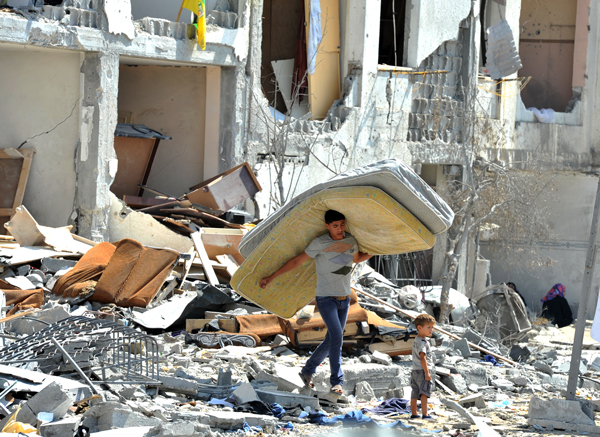The Ongoing Assault on Gaza
June 8, 2015 | Revolution Newspaper | revcom.us
On June 3, Israeli F-16 fighter jets criss-crossed the skies over the Gaza Strip, the tiny Palestinian enclave surrounded by Israeli barbed wire, menacing the population for hours. On May 26, Israeli F-16s had pounded targets in Rafah on the Egyptian border, and Khan Younis, a huge Palestinian refugee area next to Gaza City. Israel’s attacks were supposedly in “retaliation” for one projectile fired from Gaza into Israel earlier in the day. There were no injuries in Israel from this incident.
It is less than a year since Israeli forces wreaked massive destruction on the people of the Gaza Strip for 50 straight days in July and August of 2014. In this extended slaughter in Gaza, according to the United Nations Human Rights Council report of September 22, 2014, “Some 1,479 of a total of 2,158 Palestinian fatalities were civilians, of them 506 were children. On the Israeli side, 66 soldiers and five civilians were killed. More than 100,000 Palestinians in Gaza were left without a habitable home to return to, and 497,000 people had been internally displaced.”

A Palestinian salvaging some of his family's belongings after an Israeli air strike in the northern Gaza Strip, August, 2014. Photo: UN Photo/Shareef Sarhan
The United Nations Relief and Works Agency for Palestine Refugees in the Near East (UNRWA) says: “Not a single home has been rebuilt” since Israel’s assault on Gaza in 2014. Conditions of life for the 1.8 million Palestinians in Gaza are increasingly desperate at best. Israel has sealed off the Gaza Strip since 2007, restricting vital food, water, construction and medicine supplies. Israeli politicians cynically call this “putting Gaza on a diet.” And it is official Israeli policy that it must periodically “mow the lawn” by carrying out terroristic rocket and missile attacks on targets in Gaza. International observers regularly describe Gaza as the “world’s largest open-air prison.”
A recent report from the World Bank states that 40 percent of Gazans live in poverty, even though around 80 percent receive some sort of aid. It also reveals that less than a third of the $3.5 billion in reconstruction aid promised by governments around the world after Israel’s 2014 blitzkreig has actually been delivered. You would expect that world powers that regularly trumpet their commitment to human rights would be rushing to assist the people of Gaza. The USA, the so-called “leader of the free world,” pledged a mere $414 million total and only a fraction of this has been released.
This again focuses up the question: What about the people of Gaza? Wrapping your head around so many human beings forced to live this way is hard to do. With at least 60 percent of youth unemployed, on top of the daily hunger, the destroyed infrastructure, and the constant murderous Israeli siege, some turn to reactionary religious fundamentalism, others hold on to vague hopes for a better future, some fall victim to a false escape through drug addiction. A recent article in the New York Times told a slice of truth about the despair that covers much of Gaza like a fog. It quotes a 24-year-old former drug user: “It’s the unemployment, the lack of security, the pressure, the blockade. Imagine waiting for months to leave Gaza.”
The New York Times article also touches on the deep-going traumatization of the people in Gaza that has the potential of destroying a whole generation of young Palestinians, even if they survive the physical slaughter by Israel. Just one of hundreds of thousands of similarly afflicted Gazan children is highlighted: “Hamada Zaim, 4, has already lived through two short wars, in 2012 and 2014. He wets his bed and wakes up screaming at night, said his mother, Reem. Between wars, he went bald and his head began swelling.”
We should also hear the testimony of Mohammed Omer, a journalist living and working in Rafah, Gaza, who writes about the horror of the 2014 Israeli war on Gaza: “At just three months old, my son Omar cries, swaddled in his crib. It’s dark. The electricity and water are out. My wife frantically tries to comfort him, shield him and assure him as tears stream down her face. This night Omar’s lullaby is Israel’s rendition of Wagner’s Ride of the Valkyries, with F-16s forming the ground-pounding percussion, Hellfire missiles leading the wind instruments and drones representing the string section. All around us crashing bombs from Israeli gunships and ground-based mortars complete the symphony, their sound as distinct as the infamous Wagner tubas.” (Excerpt from Mohammed Omer’s Shell-Shocked, 2015)
And look at the story of Khan Younis, the sprawling refugee camp in Gaza City. The term “refugee camp” implies a temporary dwelling, from which people find permanent and secure housing. Not so! Khan Younis was established in 1948 when the Nakba, or “Catastrophe,” brought the establishment of the state of Israel that stole the land and forced the exit of at least 750,000 Palestinians. 35,000 Palestinians ended up at the Khan Younis site in 1948. In 1956, Israel rampaged through Gaza on its way to try to seize the Suez Canal from Egypt, killing 275 Palestinians. More people swelled the camp in 1967, when Israel invaded and occupied Gaza and the West Bank. Now, the population of Khan Younis has doubled from its original number, and it is always a prime target when Israeli F-16s thunder over Gaza.
To answer the question about the fate of the people of Gaza, there is one overriding fact. The raw truth is that there is no part of U.S. “concern” about the lives of Palestinians, especially those confined in Gaza, which is not fundamentally framed by what Obama has called “the unbreakable bond between the United States and Israel, and our ironclad commitment to making sure that Israel is secure.” That “bond” is based on the role Israel has played for decades as a violent enforcer for the interests of the U.S. empire in the Middle East and around the world. And one requirement for Israeli security is the continuing imprisonment and genocide against the people of Gaza.
It is Israel and the United States that are responsible for the misery in Gaza, but Hamas—the Islamic fundamentalist group that is the elected government of Gaza—is a link in the chain of oppression around the necks of the Palestinian people. Hamas rule has brought deeper oppression for women in Gaza. And while Hamas issues anti-Israel proclamations, their vision and actions fundamentally serve to tighten the chains that keep the Palestinian people oppressed by capitalism-imperialism and under genocidal assault by Israel. The painful fact that growing disgust with Hamas gets expressed in the emergence of new forms of jihadist trends in Gaza—including some that apparently look on one level or another to ISIS as a model—points to the urgency of really bringing forward another way in the region, and the world—based on liberating all humanity and ending all oppression and in that context ending the oppression and dispossession of the Palestinian people.
There are real policy differences between the U.S. imperialists and Israel, their most reliable base in the Middle East, particularly in how to contend with the influence of Iran in the region. But no one should delude themselves into thinking this in any way weakens the “bedrock” partnership between the two powers in dominating the Middle East.
To honestly look at what it would take to end the misery of Gaza, it is necessary to fight for a world that is not dominated by imperialism and a Middle East that is not living in the shadows of U.S. and Israeli invasions and genocide.
Volunteers Needed... for revcom.us and Revolution
If you like this article, subscribe, donate to and sustain Revolution newspaper.








